Xin Shen
Trust-Aware Diversion for Data-Effective Distillation
Feb 07, 2025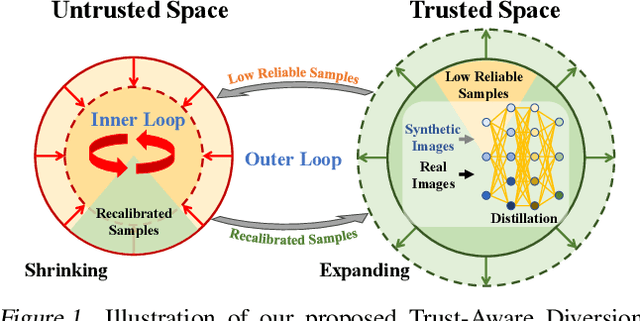
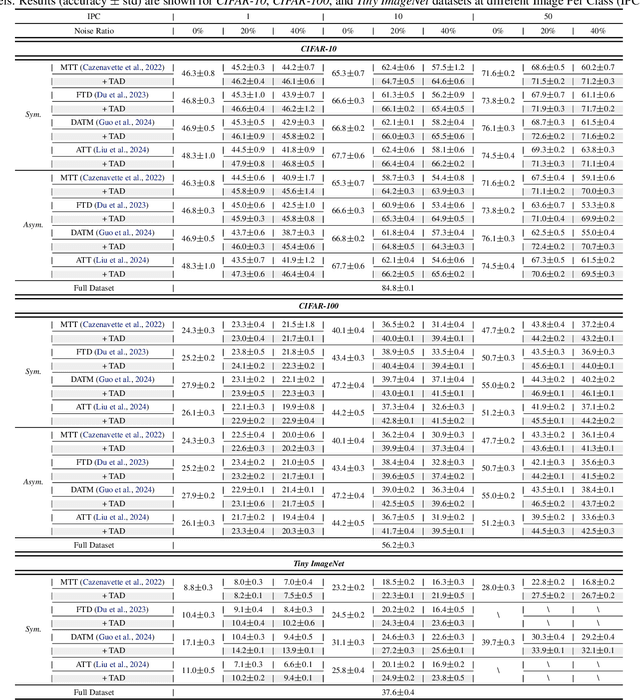
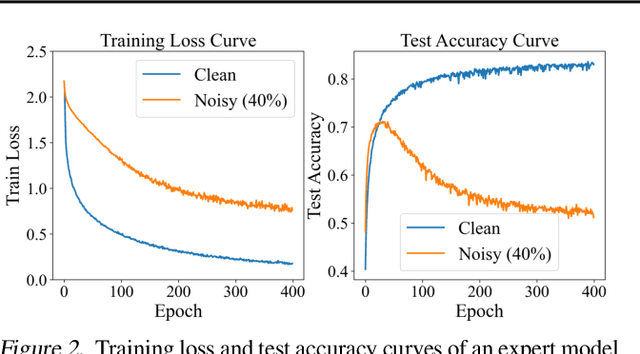
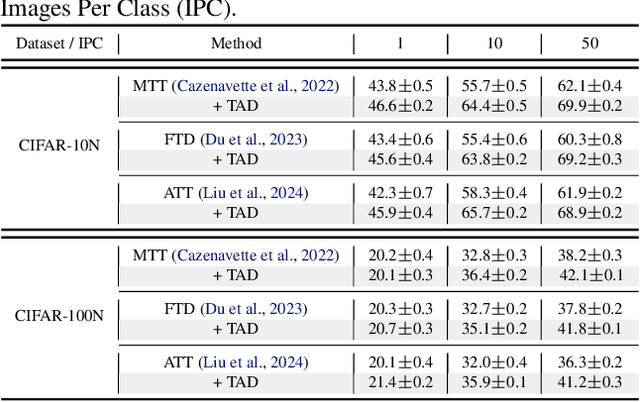
Abstract:Dataset distillation compresses a large dataset into a small synthetic subset that retains essential information. Existing methods assume that all samples are perfectly labeled, limiting their real-world applications where incorrect labels are ubiquitous. These mislabeled samples introduce untrustworthy information into the dataset, which misleads model optimization in dataset distillation. To tackle this issue, we propose a Trust-Aware Diversion (TAD) dataset distillation method. Our proposed TAD introduces an iterative dual-loop optimization framework for data-effective distillation. Specifically, the outer loop divides data into trusted and untrusted spaces, redirecting distillation toward trusted samples to guarantee trust in the distillation process. This step minimizes the impact of mislabeled samples on dataset distillation. The inner loop maximizes the distillation objective by recalibrating untrusted samples, thus transforming them into valuable ones for distillation. This dual-loop iteratively refines and compensates for each other, gradually expanding the trusted space and shrinking the untrusted space. Experiments demonstrate that our method can significantly improve the performance of existing dataset distillation methods on three widely used benchmarks (CIFAR10, CIFAR100, and Tiny ImageNet) in three challenging mislabeled settings (symmetric, asymmetric, and real-world).
MM-WLAuslan: Multi-View Multi-Modal Word-Level Australian Sign Language Recognition Dataset
Oct 25, 2024



Abstract:Isolated Sign Language Recognition (ISLR) focuses on identifying individual sign language glosses. Considering the diversity of sign languages across geographical regions, developing region-specific ISLR datasets is crucial for supporting communication and research. Auslan, as a sign language specific to Australia, still lacks a dedicated large-scale word-level dataset for the ISLR task. To fill this gap, we curate \underline{\textbf{the first}} large-scale Multi-view Multi-modal Word-Level Australian Sign Language recognition dataset, dubbed MM-WLAuslan. Compared to other publicly available datasets, MM-WLAuslan exhibits three significant advantages: (1) the largest amount of data, (2) the most extensive vocabulary, and (3) the most diverse of multi-modal camera views. Specifically, we record 282K+ sign videos covering 3,215 commonly used Auslan glosses presented by 73 signers in a studio environment. Moreover, our filming system includes two different types of cameras, i.e., three Kinect-V2 cameras and a RealSense camera. We position cameras hemispherically around the front half of the model and simultaneously record videos using all four cameras. Furthermore, we benchmark results with state-of-the-art methods for various multi-modal ISLR settings on MM-WLAuslan, including multi-view, cross-camera, and cross-view. Experiment results indicate that MM-WLAuslan is a challenging ISLR dataset, and we hope this dataset will contribute to the development of Auslan and the advancement of sign languages worldwide. All datasets and benchmarks are available at MM-WLAuslan.
Diverse Sign Language Translation
Oct 25, 2024



Abstract:Like spoken languages, a single sign language expression could correspond to multiple valid textual interpretations. Hence, learning a rigid one-to-one mapping for sign language translation (SLT) models might be inadequate, particularly in the case of limited data. In this work, we introduce a Diverse Sign Language Translation (DivSLT) task, aiming to generate diverse yet accurate translations for sign language videos. Firstly, we employ large language models (LLM) to generate multiple references for the widely-used CSL-Daily and PHOENIX14T SLT datasets. Here, native speakers are only invited to touch up inaccurate references, thus significantly improving the annotation efficiency. Secondly, we provide a benchmark model to spur research in this task. Specifically, we investigate multi-reference training strategies to enable our DivSLT model to achieve diverse translations. Then, to enhance translation accuracy, we employ the max-reward-driven reinforcement learning objective that maximizes the reward of the translated result. Additionally, we utilize multiple metrics to assess the accuracy, diversity, and semantic precision of the DivSLT task. Experimental results on the enriched datasets demonstrate that our DivSLT method achieves not only better translation performance but also diverse translation results.
Divide and Ensemble: Progressively Learning for the Unknown
Oct 09, 2023
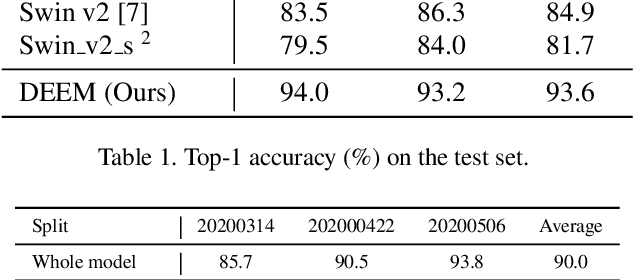


Abstract:In the wheat nutrient deficiencies classification challenge, we present the DividE and EnseMble (DEEM) method for progressive test data predictions. We find that (1) test images are provided in the challenge; (2) samples are equipped with their collection dates; (3) the samples of different dates show notable discrepancies. Based on the findings, we partition the dataset into discrete groups by the dates and train models on each divided group. We then adopt the pseudo-labeling approach to label the test data and incorporate those with high confidence into the training set. In pseudo-labeling, we leverage models ensemble with different architectures to enhance the reliability of predictions. The pseudo-labeling and ensembled model training are iteratively conducted until all test samples are labeled. Finally, the separated models for each group are unified to obtain the model for the whole dataset. Our method achieves an average of 93.6\% Top-1 test accuracy~(94.0\% on WW2020 and 93.2\% on WR2021) and wins the 1$st$ place in the Deep Nutrient Deficiency Challenge~\footnote{https://cvppa2023.github.io/challenges/}.
G-STO: Sequential Main Shopping Intention Detection via Graph-Regularized Stochastic Transformer
Jun 25, 2023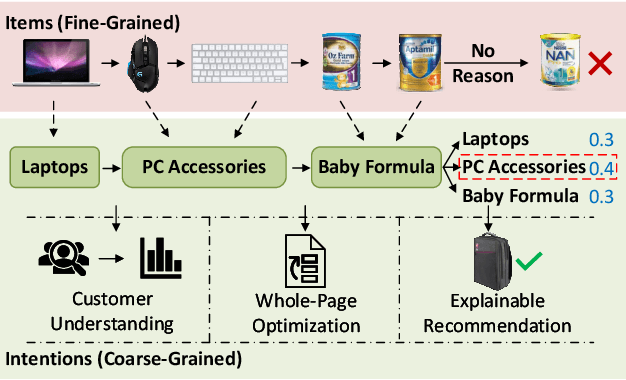

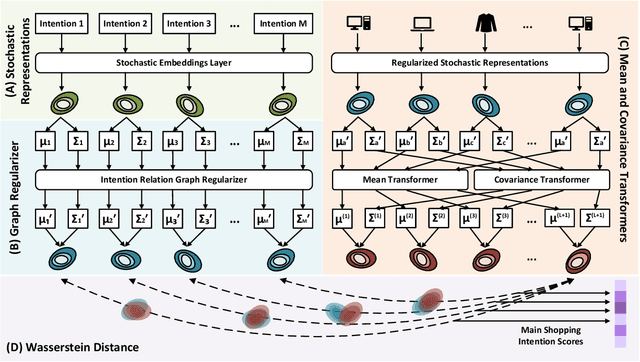

Abstract:Sequential recommendation requires understanding the dynamic patterns of users' behaviors, contexts, and preferences from their historical interactions. Most existing works focus on modeling user-item interactions only from the item level, ignoring that they are driven by latent shopping intentions (e.g., ballpoint pens, miniatures, etc). The detection of the underlying shopping intentions of users based on their historical interactions is a crucial aspect for e-commerce platforms, such as Amazon, to enhance the convenience and efficiency of their customers' shopping experiences. Despite its significance, the area of main shopping intention detection remains under-investigated in the academic literature. To fill this gap, we propose a graph-regularized stochastic Transformer method, G-STO. By considering intentions as sets of products and user preferences as compositions of intentions, we model both of them as stochastic Gaussian embeddings in the latent representation space. Instead of training the stochastic representations from scratch, we develop a global intention relational graph as prior knowledge for regularization, allowing relevant shopping intentions to be distributionally close. Finally, we feed the newly regularized stochastic embeddings into Transformer-based models to encode sequential information from the intention transitions. We evaluate our main shopping intention identification model on three different real-world datasets, where G-STO achieves significantly superior performances to the baselines by 18.08% in Hit@1, 7.01% in Hit@10, and 6.11% in NDCG@10 on average.
Text Is All You Need: Learning Language Representations for Sequential Recommendation
May 23, 2023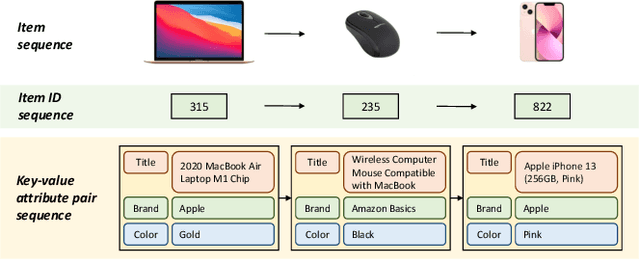
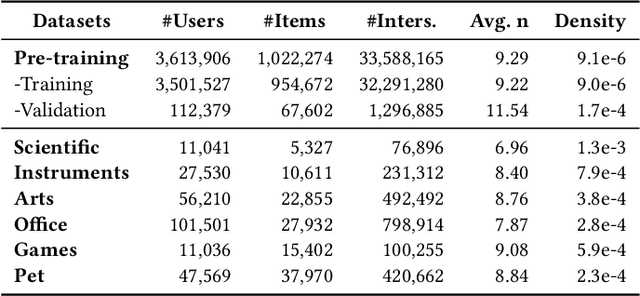

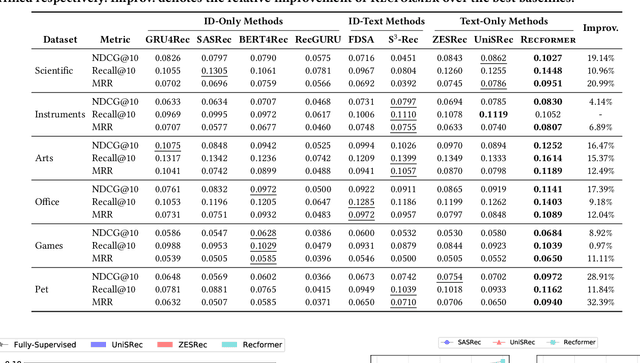
Abstract:Sequential recommendation aims to model dynamic user behavior from historical interactions. Existing methods rely on either explicit item IDs or general textual features for sequence modeling to understand user preferences. While promising, these approaches still struggle to model cold-start items or transfer knowledge to new datasets. In this paper, we propose to model user preferences and item features as language representations that can be generalized to new items and datasets. To this end, we present a novel framework, named Recformer, which effectively learns language representations for sequential recommendation. Specifically, we propose to formulate an item as a "sentence" (word sequence) by flattening item key-value attributes described by text so that an item sequence for a user becomes a sequence of sentences. For recommendation, Recformer is trained to understand the "sentence" sequence and retrieve the next "sentence". To encode item sequences, we design a bi-directional Transformer similar to the model Longformer but with different embedding layers for sequential recommendation. For effective representation learning, we propose novel pretraining and finetuning methods which combine language understanding and recommendation tasks. Therefore, Recformer can effectively recommend the next item based on language representations. Extensive experiments conducted on six datasets demonstrate the effectiveness of Recformer for sequential recommendation, especially in low-resource and cold-start settings.
Data Efficient Training with Imbalanced Label Sample Distribution for Fashion Detection
May 15, 2023



Abstract:Multi-label classification models have a wide range of applications in E-commerce, including visual-based label predictions and language-based sentiment classifications. A major challenge in achieving satisfactory performance for these tasks in the real world is the notable imbalance in data distribution. For instance, in fashion attribute detection, there may be only six 'puff sleeve' clothes among 1000 products in most E-commerce fashion catalogs. To address this issue, we explore more data-efficient model training techniques rather than acquiring a huge amount of annotations to collect sufficient samples, which is neither economic nor scalable. In this paper, we propose a state-of-the-art weighted objective function to boost the performance of deep neural networks (DNNs) for multi-label classification with long-tailed data distribution. Our experiments involve image-based attribute classification of fashion apparels, and the results demonstrate favorable performance for the new weighting method compared to non-weighted and inverse-frequency-based weighting mechanisms. We further evaluate the robustness of the new weighting mechanism using two popular fashion attribute types in today's fashion industry: sleevetype and archetype.
Semantic Embedded Deep Neural Network: A Generic Approach to Boost Multi-Label Image Classification Performance
May 15, 2023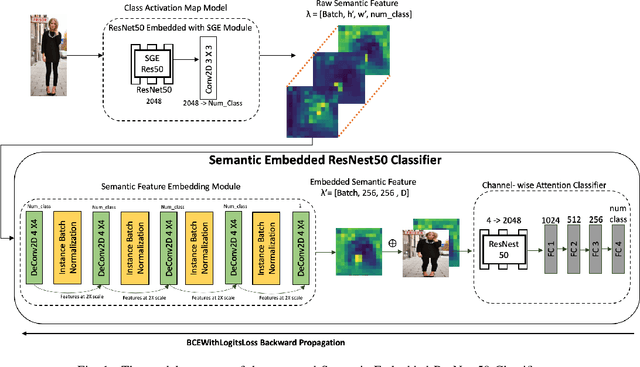


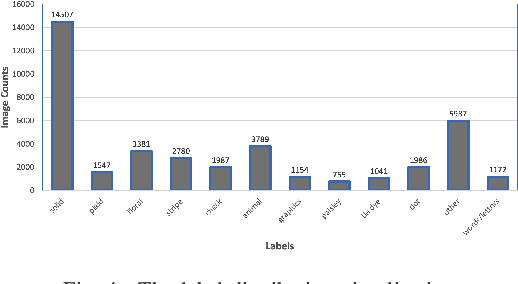
Abstract:Fine-grained multi-label classification models have broad applications in Amazon production features, such as visual based label predictions ranging from fashion attribute detection to brand recognition. One challenge to achieve satisfactory performance for those classification tasks in real world is the wild visual background signal that contains irrelevant pixels which confuses model to focus onto the region of interest and make prediction upon the specific region. In this paper, we introduce a generic semantic-embedding deep neural network to apply the spatial awareness semantic feature incorporating a channel-wise attention based model to leverage the localization guidance to boost model performance for multi-label prediction. We observed an Avg.relative improvement of 15.27% in terms of AUC score across all labels compared to the baseline approach. Core experiment and ablation studies involve multi-label fashion attribute classification performed on Instagram fashion apparels' image. We compared the model performances among our approach, baseline approach, and 3 alternative approaches to leverage semantic features. Results show favorable performance for our approach.
Learning to Personalize Recommendation based on Customers' Shopping Intents
May 10, 2023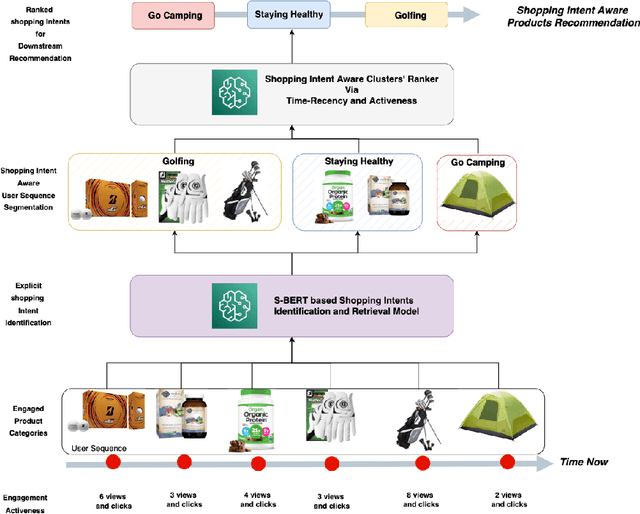
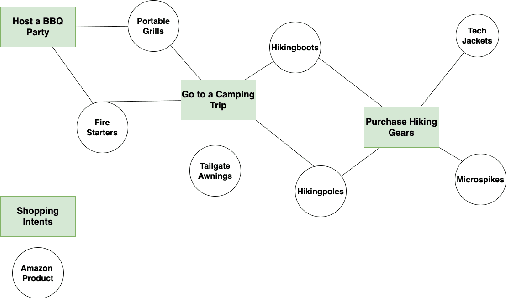
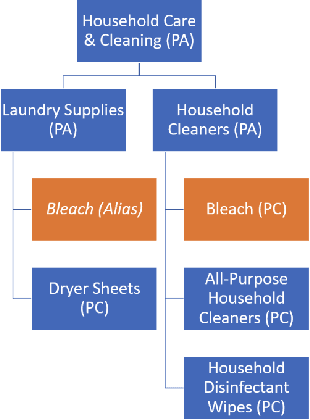
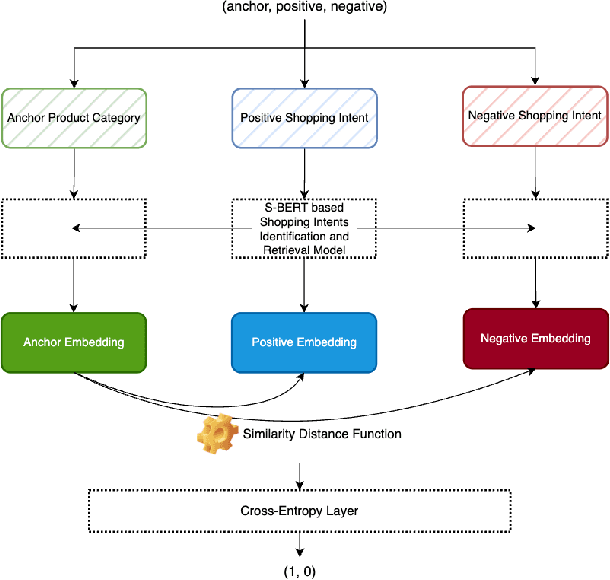
Abstract:Understanding the customers' high level shopping intent, such as their desire to go camping or hold a birthday party, is critically important for an E-commerce platform; it can help boost the quality of shopping experience by enabling provision of more relevant, explainable, and diversified recommendations. However, such high level shopping intent has been overlooked in the industry due to practical challenges. In this work, we introduce Amazon's new system that explicitly identifies and utilizes each customer's high level shopping intents for personalizing recommendations. We develop a novel technique that automatically identifies various high level goals being pursued by the Amazon customers, such as "go camping", and "preparing for a beach party". Our solution is in a scalable fashion (in 14 languages across 21 countries). Then a deep learning model maps each customer's online behavior, e.g. product search and individual item engagements, into a subset of high level shopping intents. Finally, a realtime ranker considers both the identified intents as well as the granular engagements to present personalized intent-aware recommendations. Extensive offline analysis ensures accuracy and relevance of the new recommendations and we further observe an 10% improvement in the business metrics. This system is currently serving online traffic at amazon.com, powering several production features, driving significant business impacts
Learning Personalized Page Content Ranking Using Customer Representation
May 09, 2023Abstract:On E-commerce stores (Amazon, eBay etc.) there are rich recommendation content to help shoppers shopping more efficiently. However given numerous products, it's crucial to select most relevant content to reduce the burden of information overload. We introduced a content ranking service powered by a linear causal bandit algorithm to rank and select content for each shopper under each context. The algorithm mainly leverages aggregated customer behavior features, and ignores single shopper level past activities. We study the problem of inferring shoppers interest from historical activities. We propose a deep learning based bandit algorithm that incorporates historical shopping behavior, customer latent shopping goals, and the correlation between customers and content categories. This model produces more personalized content ranking measured by 12.08% nDCG lift. In the online A/B test setting, the model improved 0.02% annualized commercial impact measured by our business metric, validating its effectiveness.
 Add to Chrome
Add to Chrome Add to Firefox
Add to Firefox Add to Edge
Add to Edge